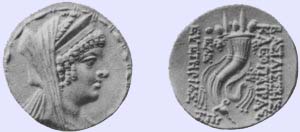|
|
Coin of Cleopatra Thea. Reverse shows a double cornucopia. The Greek text reads ΒΑΣΙΛΙΣΣΗΣ ΚΛΕΟΠΑΤΡΑΣ ΘΕΑΣ ΕΥΕΤΗΡΙΑΣ. The date ΖΠΡ is year 187 of the Seleucid era, corresponding to 126 –125 BC.[. They certainly had Antiochus IX Cyzicenus, but the names of any other children are uncertain. In about 129 BC, Antiochus was killed fighting the Parthians. Demetrius had been released and returned home to reclaim his throne and queen. Cleopatra had taken the precaution of sending Antiochus IX (her son by Antiochus VII) to Cyzicus in Asia Minor (hence his surname). Demetrius unsuccessfully attempted to invade Egypt. In retaliation, the ruler of Egypt put forward Alexander Zabinas, allegedly a son of Alexander Balas as king of Syria, provoking civil war. After a defeat by Zabinas' forces at Damascus, Demetrius retreated to Ptolemais Hermiou only to find the city gates closed against him by Cleopatra. He boarded a ship to flee, but was killed on Cleopatra's orders. From 125 BC to 121 BC, Cleopatra ruled Syria, killing Demetrius' eldest son Seleucus when he attempted to claim the throne. To legitimize her reign, she shared the throne with her son Antiochus VIII Grypus. Antiochus became less controllable as he grew up and in 121 BC, she decided to eliminate him. As he returned from a hunt one day, she offered him a cup of wine. Since this was not common behavior for her, Antiochus was suspicious and forced her to drink the wine, with the predictable outcome. Seleucid Ruler Retrieved from "http://en.wikipedia.org/"
 |
|
|||||||||||||||||
